Rare breed hull
A couple of years ago, I became interested in modding. More precisely, as I got carried away - there was an interest and a lot of crazy ideas, but I myself did something very reluctantly. Maybe due to the fact that in practice my capabilities did not correspond to the severity of my pans - so inaccurately nagging a couple of times something there with minimal pleasure and hid the results to hell.

My “masterpieces” did not differ in their uniqueness, however, like many other modders' handicrafts - airbrushing, slotted windows, lighting ... In 99% of cases, this is not very nice and even boring.
When I first saw a photo of the Thermaltake Level 10 case (it was a soap snapshot with a “ No photo ” sign at the exhibition), only two thoughts appeared in my head - “Nothing but… !!!” and “How could I not have thought of that?” ... although, what is already there, anyway, so I definitely would not have done. " In general, I looked then, I admired ... and somehow everything was forgotten by itself - the “meeting in real life” could not be seen even on the horizon, but I also didn’t want to drool.
')
And then I visited the other day to visit my friend, an overclocker well-known all over the world, you know him under the nickname DeDaL . Recently, he has immaculate ties with the company Thermaltake, on his desk stood the building mentioned above and ... and all this time he was silent!
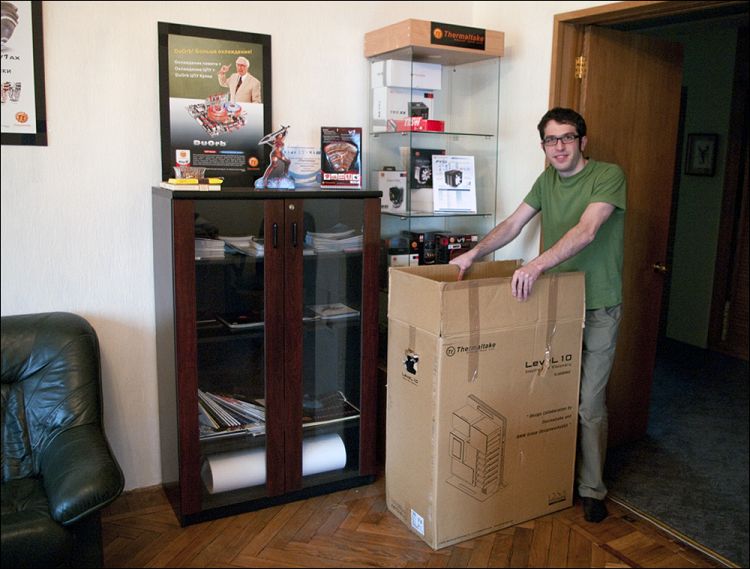
So, the Thermaltake Level 10 building was first introduced in Hanover at CeBIT 2009 - by its tenth anniversary, the company decided to please itself and its fans with such an unusual gift. In addition to the engineers from TT, a team of designers from the BMW Group worked on him - I think you could have heard about them before) Come on, why pull the cat by the tail - let's go straight to reviewing the piece of iron.
It all starts with a huge cardboard box - it is almost the size of a DeDaL. A) Inside the unsightly “skin” there is another box, already more rounded.
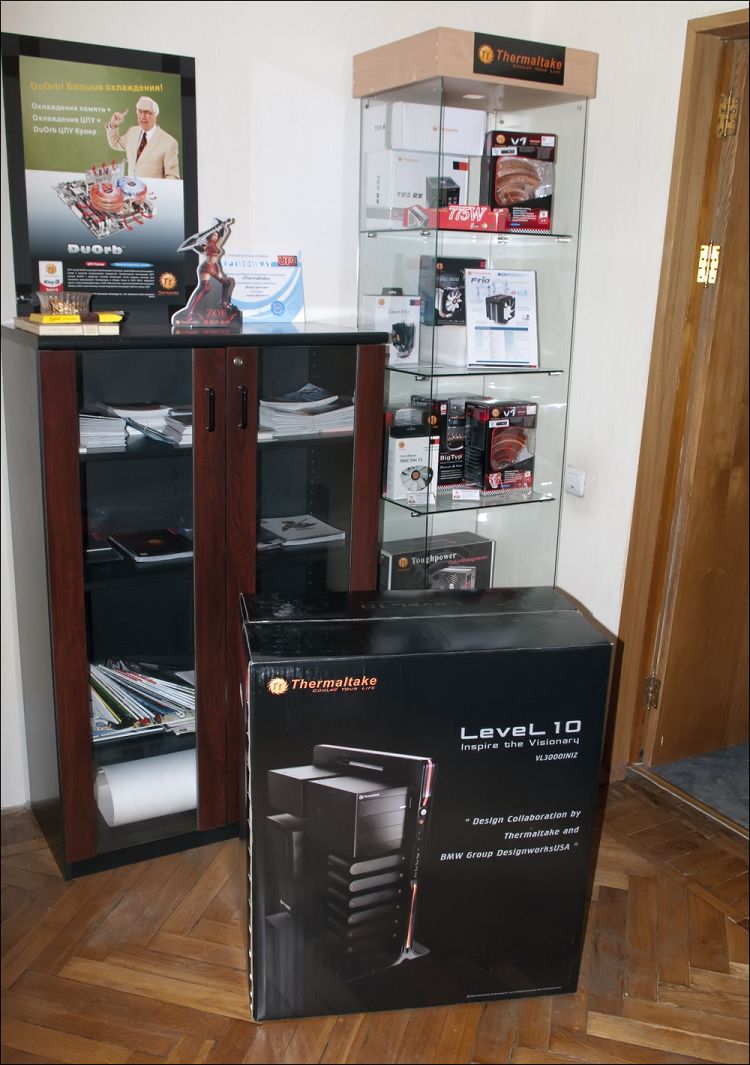
The body itself, the manual for it, the fibro-rag and one more box are found in the foam plastic, but this time it is quite small - there are all sorts of trifles in it.
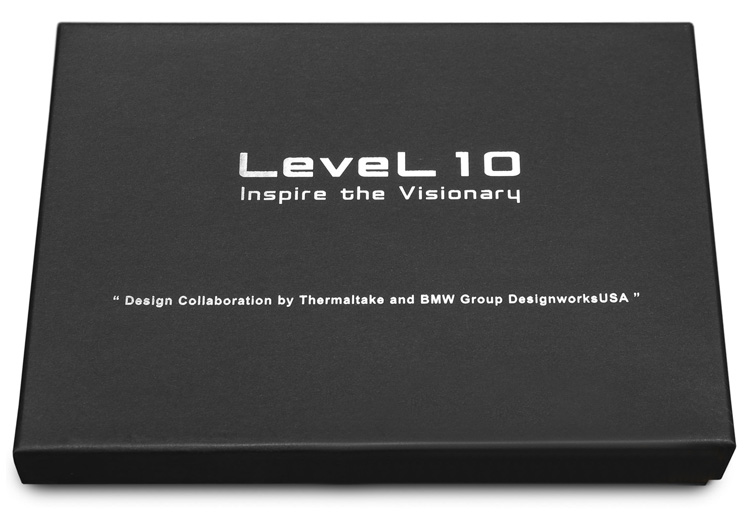
Namely: 4 sachets of screws (for power supply, drives, disks and motherboard); two keys to the case; carabiner for keys and several clamps styled for the body. Everything is neatly folded up - the difference between a conventional piece of iron and a piece of metal of the “lukhuri” class begins to be felt slowly.
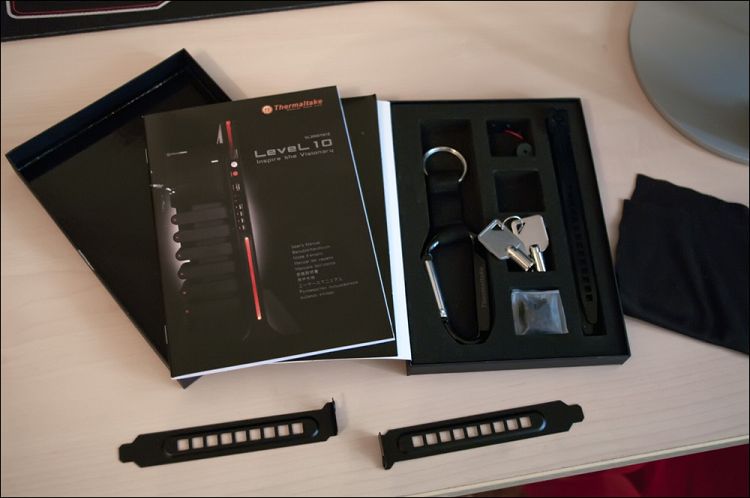
It seems there was nothing else, although it would seem that the floor of the plane would fit in such a box. On the other hand, what else is needed? Put the manufacturer there BMW X6 model in 1:43 scale and in the comments there will be exclamations like “To buy this case only because it has BMW X6 model ???” :)

It is not so easy to get the case - judging by the unambiguous inscription on the box, it weighs (without iron inside) nothing more or less - 22 kg! And with all the stuffing at all 30. Although, by the standards of such giants, this is not so much yet - the ASUS Ares gaming computer, about which I wrote , with a filling weighs almost fifty dollars.
The dimensions of the “tenth level” are also ogogo - 320 mm in width, 615 mm in depth and symbolic 666 mm in height. The last “hellish” figure has already included the height of a massive handle in the upper part of the body - without it, the body would be much more difficult. However, in the first 330 (this is the width of the base), too, it didn’t do without a pen - it all hints that it is better to carry the body together.

In general, the dimensions are very non-standard, but putting such a body under the table is the same as putting caps from Ferrari on the nine.
The design of the case is really impressive - you will not confuse it with any of the existing glands at the moment. I’m not even afraid to call it unique - this is really a new word in the body building, there’s nothing like that in a serial launch. There were, of course, manufacturers trying to create something extraordinary - from the latter I recall Antec Skeleton ... but this is not at all the same. ASUS Ares and Acer Predator - yes, it's beautiful, but they stand like a shuttle and you can't buy it without iron.
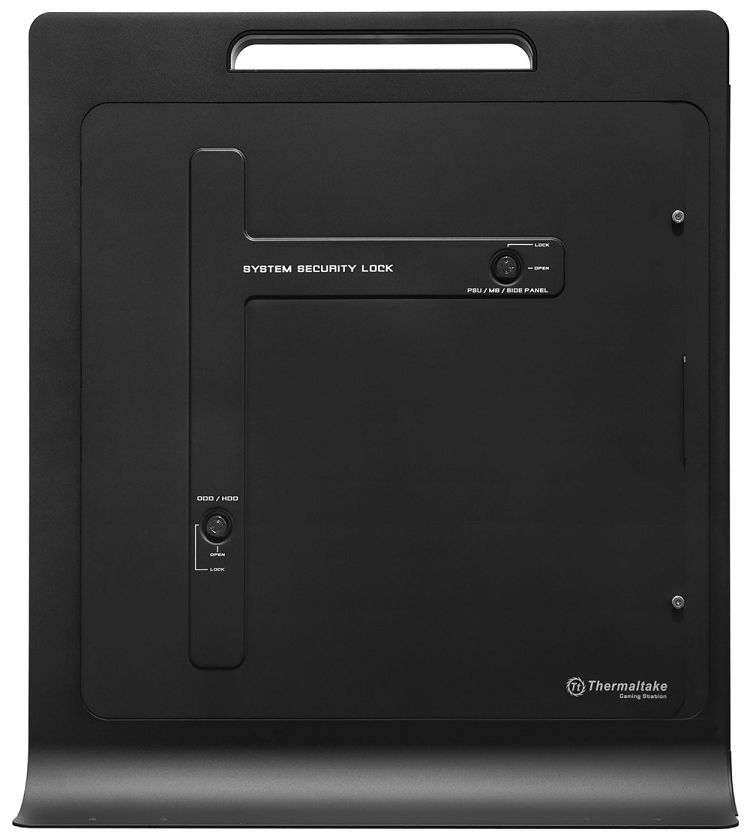
The case is black opaque, completely metal (aluminum). The wide (very stable) base smoothly passes into a perpendicularly mounted “wall”, to which the system compartments are fixed.
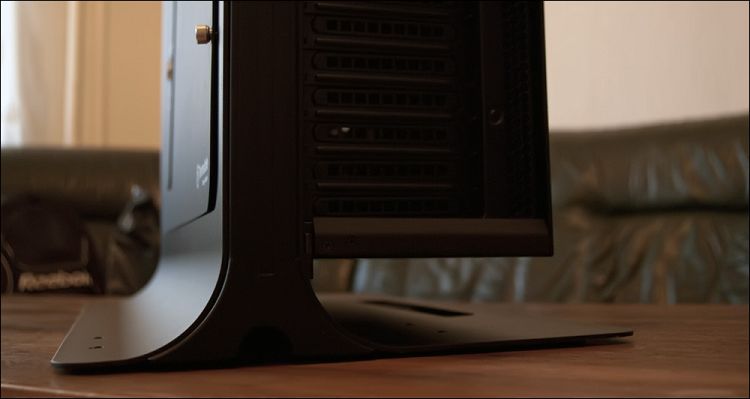
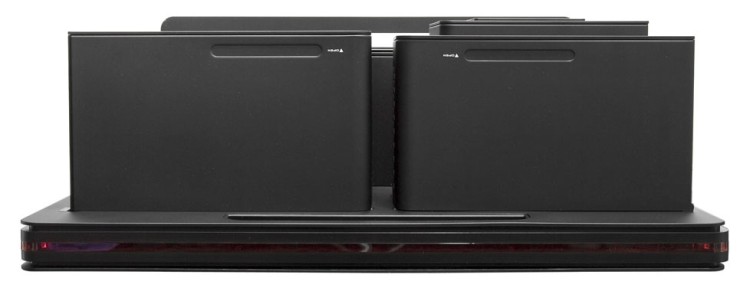
There are several of them - one for the motherboard (and everything on it), one for the power supply, one for three 5.25 "" devices and six for 3.5 "hard drives (for convenience, they are numbered).
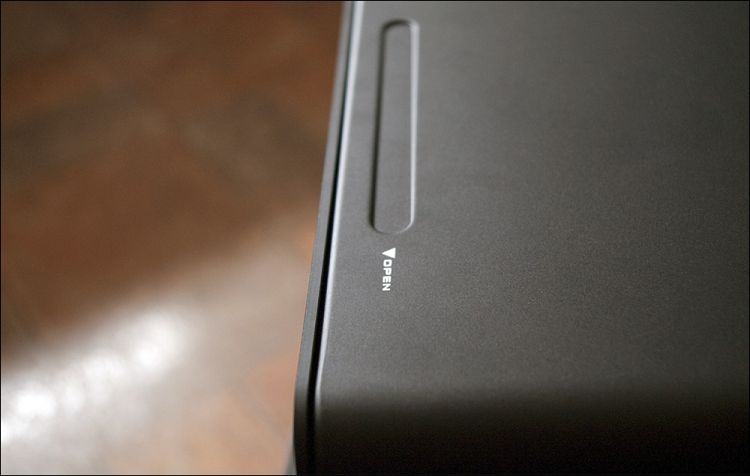
Virtually all compartments, more precisely, their covers are hinged (hinged), which allows at any time access to a particular component. Alternatively, access to the internal parts of the system can be closed on the contrary - on the back of the case there are primitive locks that can be used to lock certain covers.
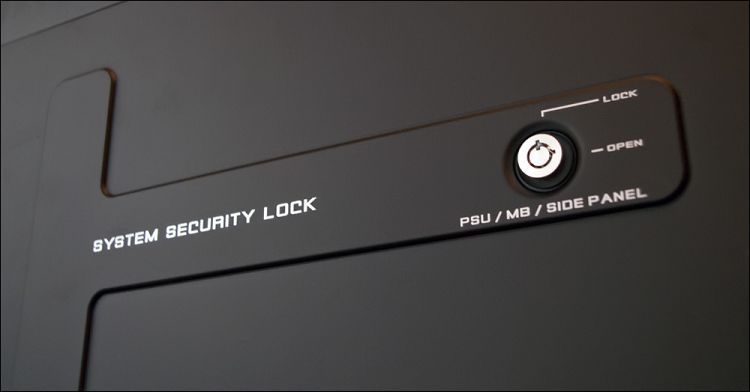

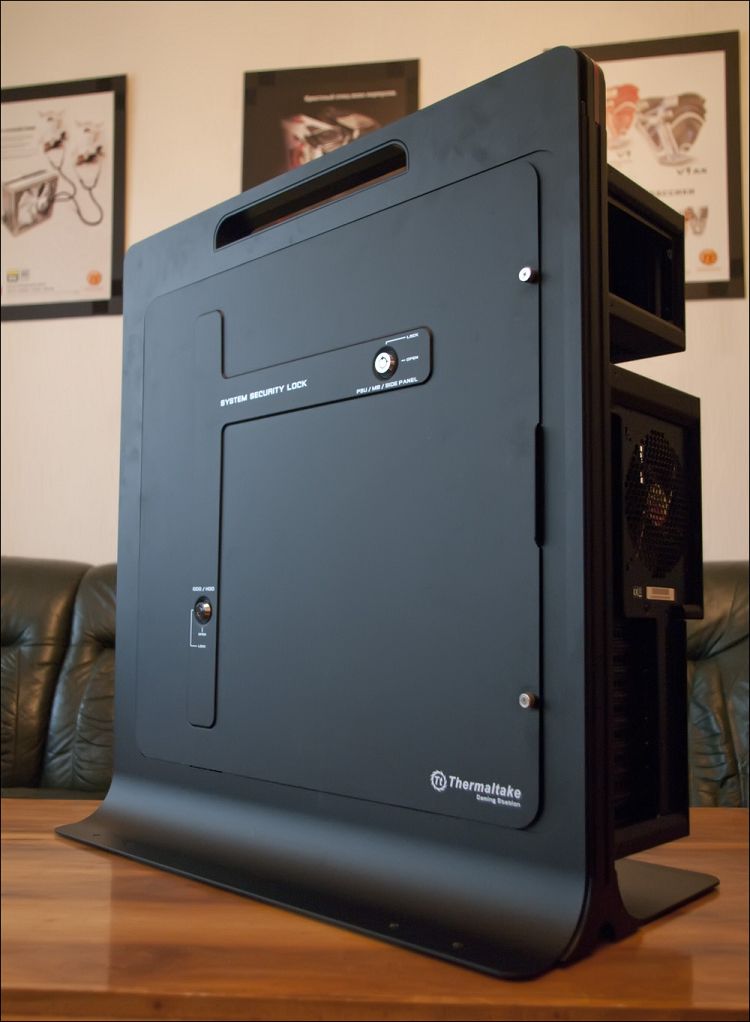
Hard drive covers can also be locked, but in the normal state, they are simply removed - thanks to the sled, you can install regular SATA screws inside.
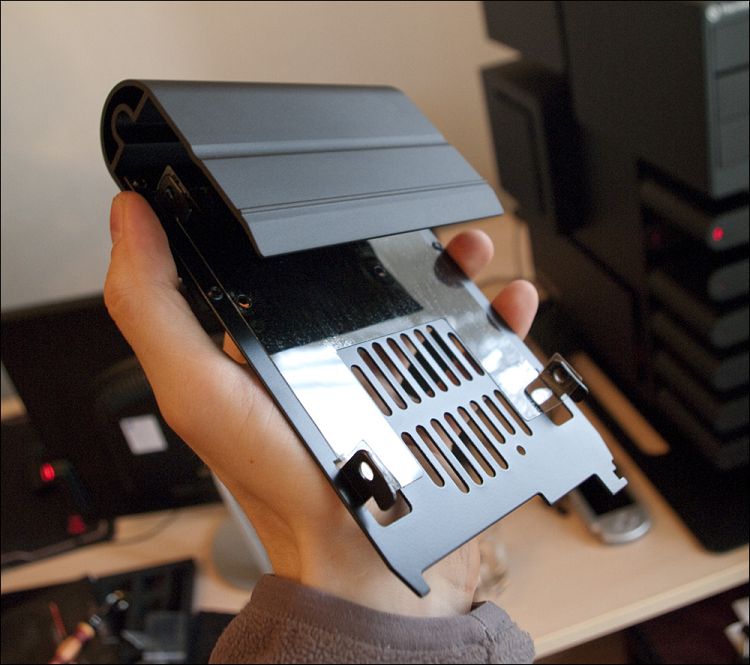
And two of them have the ability to hot swap. With the rest will have to tinker. In a special vertical rack between the disks fit 60mm cooler (2500 RPM). It is a pity that there are only two “tricked out” compartments, but do many of them have more than two hard drives in the system? Initially, there are also no tools (adapters) for installing 2.5 "- disks - for example, most SSD-drives can be put into the compartments unless they are simply put. But there is such an element of decor as LEDs - when you install the disc, a red dim “dot” lights up on the front panel - one of the few cases when the indicator doesn't want to be broken off (however, all beauty is removed by one Molex inside the case).

Since we started talking about “decor” - the Element 10 case still has LEDs that are not ashamed to show. However, so everything can be seen - almost the entire front end passes a dim red light - it continues through the entire upper part and ends somewhere near the back wall. Black with red ... mm, perhaps my favorite combination. In addition, the company itself is positioning this building as a game, and any gamers (and not only) will like this war paint.
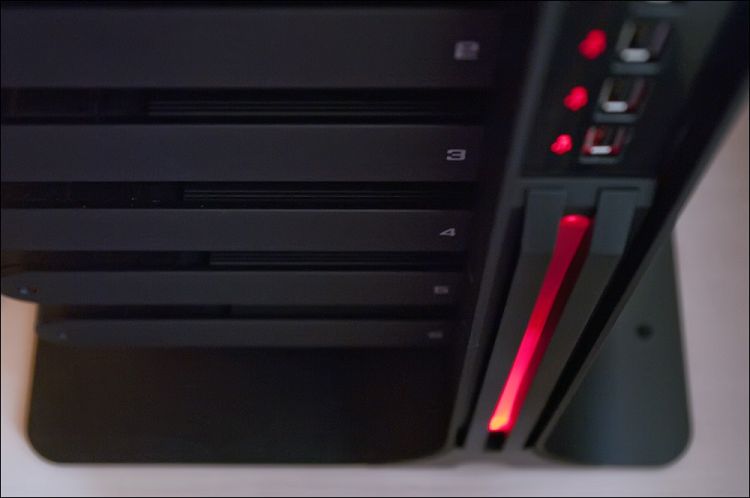
A couple of words about the front side - above the hard drives there is a “box” for three 5.25 '' devices - they all hide behind the false panels, one of which has a button (for the drive).

Accordingly, for the remaining compartments, you can hide something else - I would remove 3.5 "there - hard drives in 5.25" - Himuro cases - this would get rid of excess noise (both from the drives and the disconnected coolers in disk compartments). Moreover, each of the devices can be fixed in two positions - flush with the outer wall or "drowning" inside the panels.
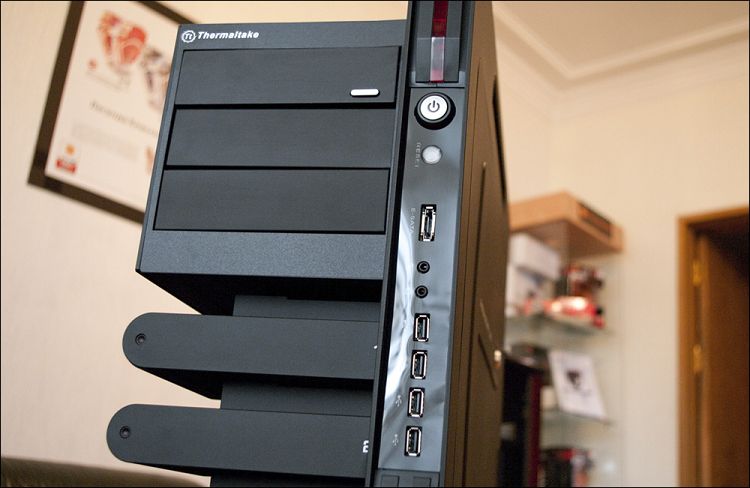
The computer is turned on with the Power button on the front panel - just below is the Reset, two audio connectors, eSATA and 4 USB ports. Not enough, perhaps, SD-reader and FireWire-connector.

Compartment for a folding power supply unit - installation of both “square” power supplies and “oblong” ones with increased power is provided. In addition to landing on the screws, the power supply unit can be additionally fixed with the movable part of the housing from above. On the cover of the compartment there are many holes through which cooling can be carried out by means of the cooler from the power supply unit.
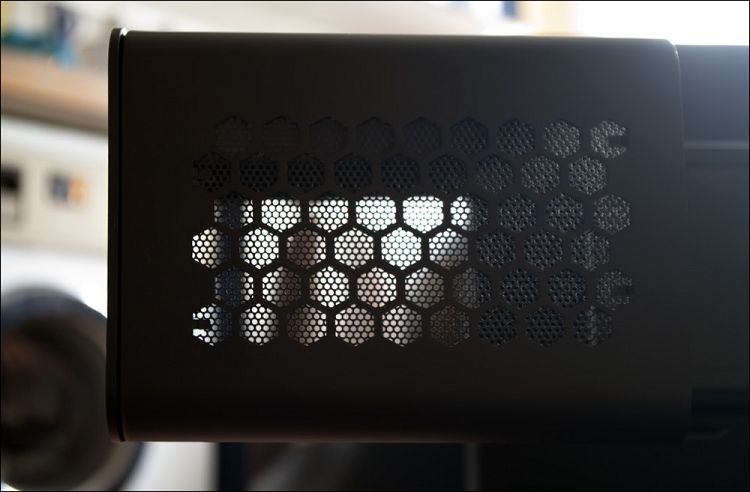

The remaining compartment - under the motherboard and all that is on it. And it is interesting in its own way. All the computers that I assembled earlier (including my own), I assembled like this - I put the motherboard on the table, installed all the components in it and then “immersed” it all inside the case - if you assemble everything in the case itself (and such There are people), you can cut-scratch against the edges of the case, and in general it is not very convenient. Here, first of all, all the edges are as accurate as possible - no burrs and other artifacts; secondly, the flip-open lid opens up such space that it is not a sin to assemble the system and closer to the “body”. So if you need access to any component of the system, it will always be - it is not necessary to disassemble the entire case. In the third - the motherboard pallet is removable, so that the menu for all tastes.
In the open state, you can see the wall of the case with a huge number of marked holes - it is clear that they are for attaching the motherboard.

On each side of each other there are two 120mm coolers - many hopes are laid on them. The depth of the compartment is quite large - it will allow you to install a wide range of system coolers, but some models will not fit there.
As for the video system, two even the largest video cards can easily fit, and, possibly, with alternative cooling systems. But attach, for example, SVO initially can not be. What is nice is that almost all the walls are perforated, and in some places dust filters are present.

For convenience, you can remove the reverse wall of the case - there, by the way, there is something to see. First, this is the window for the processor socket on the motherboard - in case you need to remove the system cooler. Secondly, the entire “infrastructure” is visible - before that, no wire had yet been seen; so for conspiracy in this regard, thermal can be put the very “ten”.
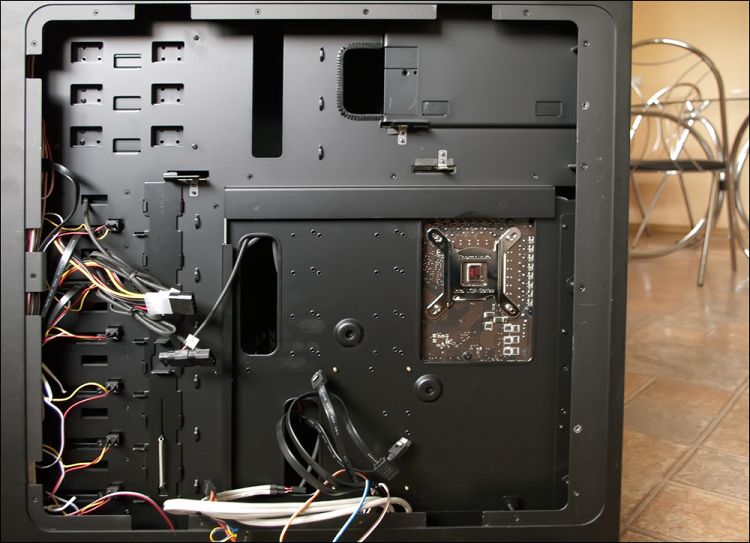
Another dozen - for the quality of the assembly as a whole - everything fits perfectly, nothing creaks or backlash, neatly and thoughtfully - as it should be.
The back side is the most common - the elements of the installed power supply are visible from above, the grid from the 120-mm cooler (Thermaltake A1225L12S to 1300RPM), working on blowing, is visible below; and just below are slots for expansion cards (there are 8 of them).


No, but what are you still waiting for? )
Sarkis (aka DeDaL) was busy collecting a test stand for one event at Gorbushka (that was the decade of the Upgrade magazine in the Mobile Plaza pavilion; it was also possible to see the building live there). During the assembly, I carried out careful monitoring.
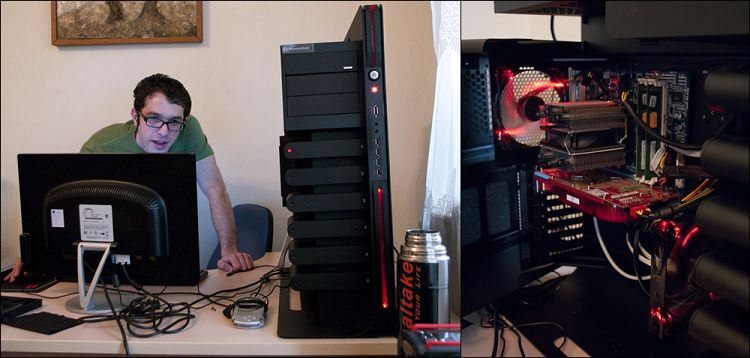
As components, he chose the following components:
Processor : Intel Core2 Extereme QX9650 @ 4400 MHz 1.4 V
Cooler : Thermaltake FRIO
Motherboard : ASUS Rampage Extereme
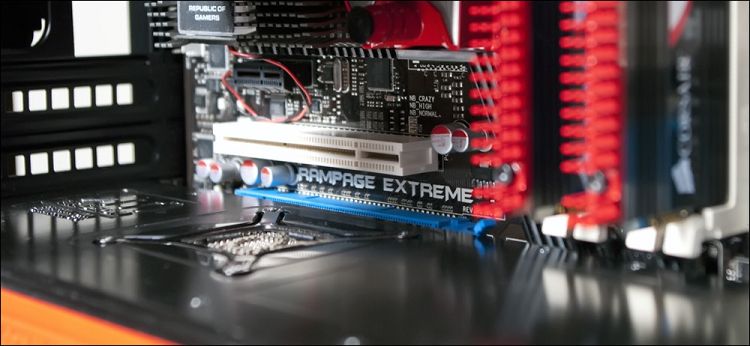
Memory : 2 * 2048MB Corsair DOMINATOR GT 2000C7
Video Card : Saphire Radeon HD5870 (normal mode)
Power supply : Thermaltake Toughpower 1000W
Hard Drive : Western Digital 1Tb
OS : Win 7 Ultimate
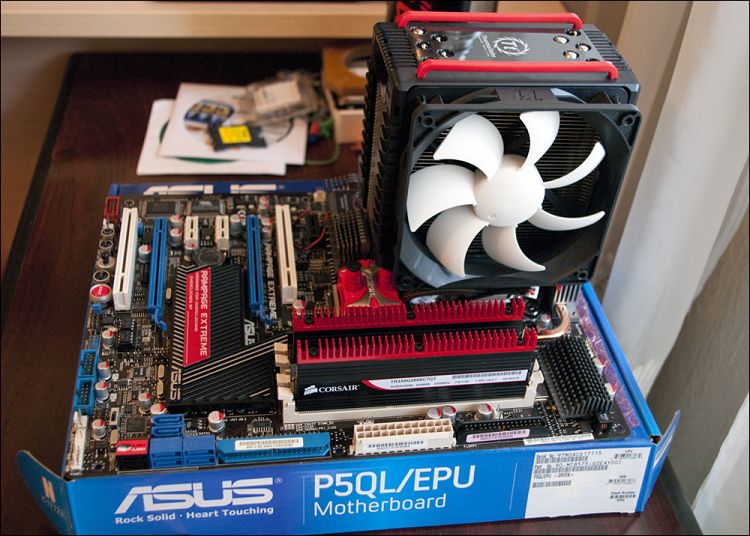
To say that there were some problems in the assembly process is to lie. Rather, even if there were any trifles, they were connected only with the specifics of the new corps and, on the contrary, it was interesting to solve them.

Well and so, by and large, it was necessary to spend time only on the power supply unit - the kilowatt model from TT was rather long and just couldn’t insert it - we had to unscrew the power supply compartment. Although I am almost sure that the standard power supply units (of which the vast majority) can be crammed in there without dismantling. The power supply compartment itself supports devices with a length of 140 to 210 mm.


The processor cooler turned out to be quite powerful - at first the lid did not close with it, but when two red decorative inserts were removed from it, everything was remarkably closed. Measurements have shown that the “door” will not close if the cooler is higher than 150mm - respectively, such cooling grants as the Noctua NH-D14 or Thermalright IFX-14 will not fit there exactly. It's a pity. Although ... if you skillfully approach from the right side and with the Dremel, then you can fit everything you want) In all seriousness - the body is a little ill-designed (at the time of designing the current "giants" simply did not exist), but the scope for modding is really unlimited ( however, the WOW-effect body was initially).
As for the video cards, the 27-centimeter ATI HD5870 was installed and it fit perfectly (the two will fit too). Of course, according to the documents, everything that is no longer than 310 mm will fit in there. Therefore, the 33-centimeter 5970 ... no, it will fit in - but only if you unscrew one regular case cooler (which is 140mm Thermaltake A1425L12S with 100RPM). It is also well known that two 295GTX are placed inside without problems.

DeDaL assembled the system on the table - for the sake of interest, to find out the temperature of the components in an open stand. And so they had time to cool down while they were being placed inside. The results are as follows.
The processor was heated by the LinX 0.6.4 stress test - the temperature was monitored by RealTemp 3.4.
The video card was heated up by a 10 minute game in Metro 2033 (since Furmark wasn’t at hand) - temperature readings were taken using MSI Afterburner 1.5.

In the load, the processor did not heat up above 69 degrees, which is 4 degrees more than an open stand.
The temperature of the video chip did not exceed 80 degrees, which is only 2 degrees higher than the temperature at an open stand. 80 degrees is not so little ... but in this case it is the result of the work of the standard turbine of the video card. I am almost sure that with an alternative cooling system, more favorable conditions can be achieved with less noise.
From which the conclusion suggests itself that the case is quite suitable for an overclocked game configuration - the temperature conditions in the load are fairly standard. The same conclusions on a hotter system were received by the author of another test of this case. I take this opportunity to express my gratitude for a few photos provided.
As for the noise level - it was not possible to listen carefully, because there was lively conversation, background music and a couple of computers working in the room. This building certainly cannot be called the standard of silence, but there was no noise unpleasant for the ears either - all within the limits of permissible norms. I think if you work on soundproofing of disks, video cards and regular coolers, the result will surpass expectations.
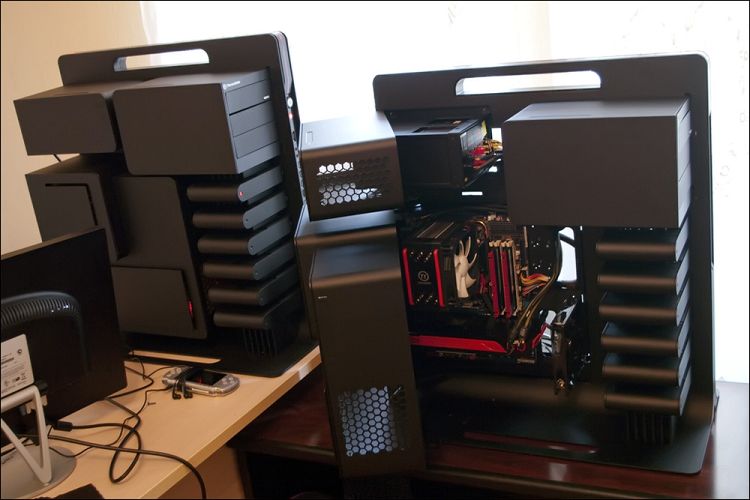

Summing up the above - the body is not only beautiful, but also copes well with its direct responsibilities.
 Unusual design - as for me, it is simply amazing;
Unusual design - as for me, it is simply amazing;
 High-quality materials, excellent build quality, a lot of well-thought-out nuances;
High-quality materials, excellent build quality, a lot of well-thought-out nuances;
 The body as a whole is very durable and stable; the ability to close the compartments on the key;
The body as a whole is very durable and stable; the ability to close the compartments on the key;
 Almost any system will operate under normal temperature conditions;
Almost any system will operate under normal temperature conditions;
 Hot swap is supported on two drives;
Hot swap is supported on two drives;
 Good equipment;
Good equipment;
 Not every system cooler fits inside; installation of CBO is not provided;
Not every system cooler fits inside; installation of CBO is not provided;
 The ability to hot swap only two disks;
The ability to hot swap only two disks;
 The hull is very large and heavy;
The hull is very large and heavy;
 Price - from 25 thousand rubles !!!
Price - from 25 thousand rubles !!!
What can I add? I do not want to act as a lawyer for the device, but I argued something like this. The case is quite a stationary thing, so once you finish 20 ... yes, even 30 kg, you can - because it is thanks to its weight that the device does not falter and does not vibrate. Sizes? Yes, in principle, they are not so outstanding. There is always a place on the floor, and on the table - as lucky there.
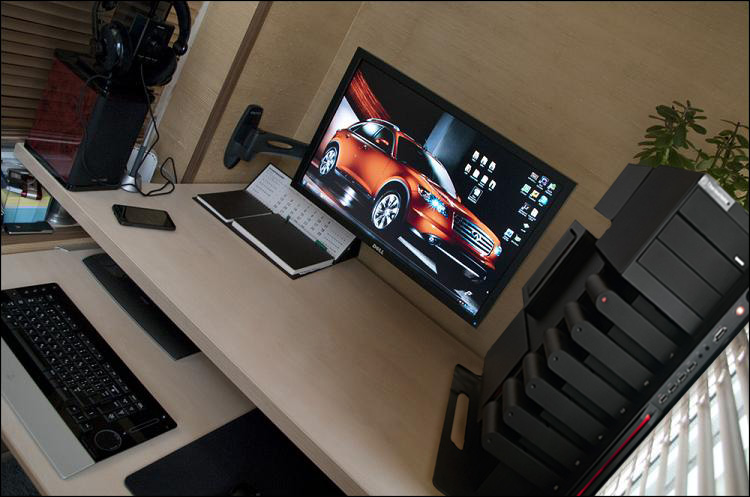
About the price - there is a double-edged sword. The product came out quite unique, and what would be unique if every third person had a case. Accordingly, the price is a kind of barrier ... although, I agree, the barrier is very high - after all, it is just a body. Which is not a shame to put on the table, but for which not everyone has so much space on the table) Well, apparently, there are some deductions for “Designed by BMW Group” - so this is an exclusively designer thing. But, again, suitable for the main task.
 Virtually every company has such products to be proud of - it can be stuffed to the obscenity of know-how, something flagship and record-breaking for some indicators or some design one - just beautiful SOMETHING with a scattering of blondes or with finishing from the skin from the back of the President of America. As a rule, such products are available in limited editions, according to military technologies and with the use of specially developed materials - all this together makes the numbers on the price tag never funny. However, as well as buying such things is not the last money. On just the inscription “Designed by BMW”, many are ready to pray, but, you see, it turned out really “really good”? Moreover, on the 10th anniversary of the company had the full right to pamper yourself with something similar.
Virtually every company has such products to be proud of - it can be stuffed to the obscenity of know-how, something flagship and record-breaking for some indicators or some design one - just beautiful SOMETHING with a scattering of blondes or with finishing from the skin from the back of the President of America. As a rule, such products are available in limited editions, according to military technologies and with the use of specially developed materials - all this together makes the numbers on the price tag never funny. However, as well as buying such things is not the last money. On just the inscription “Designed by BMW”, many are ready to pray, but, you see, it turned out really “really good”? Moreover, on the 10th anniversary of the company had the full right to pamper yourself with something similar.
The case is definitely a success. Beautiful, elegant, unusual and aggressive, but with all this, ready to perform the basic functions assigned to it. Of course, it is not necessary to wait for records, but no one promised them. And to be indignant on this point is the same as complaining about Ferrari, in which 8 bags of potatoes did not fit.
The manufacturer positions it as a game, and what is a gaming computer? This is just a set of productive glands, which fit into this building like any other. Yes, maybe something will not fit - but because of the range of alternatives, this is excusable. Maybe in the standard delivery, not everything is smooth with the noise level and the thermal regime ... but if desired, this is also possible. Yes, and something tells me that a good half of the people who can afford a given chest will absolutely not care if something is heating up inside it or making noise.
Returning to the price - it turns everything described above into a very niche product, but this is logical and does not make it less interesting. There are definitely buyers and ... what is the most terrible thing for me ... my expectations were completely justified :)
Tomorrow's Eee Keyboard Review!

Successes!

My “masterpieces” did not differ in their uniqueness, however, like many other modders' handicrafts - airbrushing, slotted windows, lighting ... In 99% of cases, this is not very nice and even boring.
When I first saw a photo of the Thermaltake Level 10 case (it was a soap snapshot with a “ No photo ” sign at the exhibition), only two thoughts appeared in my head - “Nothing but… !!!” and “How could I not have thought of that?” ... although, what is already there, anyway, so I definitely would not have done. " In general, I looked then, I admired ... and somehow everything was forgotten by itself - the “meeting in real life” could not be seen even on the horizon, but I also didn’t want to drool.
')
And then I visited the other day to visit my friend, an overclocker well-known all over the world, you know him under the nickname DeDaL . Recently, he has immaculate ties with the company Thermaltake, on his desk stood the building mentioned above and ... and all this time he was silent!


So, the Thermaltake Level 10 building was first introduced in Hanover at CeBIT 2009 - by its tenth anniversary, the company decided to please itself and its fans with such an unusual gift. In addition to the engineers from TT, a team of designers from the BMW Group worked on him - I think you could have heard about them before) Come on, why pull the cat by the tail - let's go straight to reviewing the piece of iron.
Equipment
It all starts with a huge cardboard box - it is almost the size of a DeDaL. A) Inside the unsightly “skin” there is another box, already more rounded.

The body itself, the manual for it, the fibro-rag and one more box are found in the foam plastic, but this time it is quite small - there are all sorts of trifles in it.

Namely: 4 sachets of screws (for power supply, drives, disks and motherboard); two keys to the case; carabiner for keys and several clamps styled for the body. Everything is neatly folded up - the difference between a conventional piece of iron and a piece of metal of the “lukhuri” class begins to be felt slowly.

It seems there was nothing else, although it would seem that the floor of the plane would fit in such a box. On the other hand, what else is needed? Put the manufacturer there BMW X6 model in 1:43 scale and in the comments there will be exclamations like “To buy this case only because it has BMW X6 model ???” :)

Appearance
It is not so easy to get the case - judging by the unambiguous inscription on the box, it weighs (without iron inside) nothing more or less - 22 kg! And with all the stuffing at all 30. Although, by the standards of such giants, this is not so much yet - the ASUS Ares gaming computer, about which I wrote , with a filling weighs almost fifty dollars.
The dimensions of the “tenth level” are also ogogo - 320 mm in width, 615 mm in depth and symbolic 666 mm in height. The last “hellish” figure has already included the height of a massive handle in the upper part of the body - without it, the body would be much more difficult. However, in the first 330 (this is the width of the base), too, it didn’t do without a pen - it all hints that it is better to carry the body together.

In general, the dimensions are very non-standard, but putting such a body under the table is the same as putting caps from Ferrari on the nine.
The design of the case is really impressive - you will not confuse it with any of the existing glands at the moment. I’m not even afraid to call it unique - this is really a new word in the body building, there’s nothing like that in a serial launch. There were, of course, manufacturers trying to create something extraordinary - from the latter I recall Antec Skeleton ... but this is not at all the same. ASUS Ares and Acer Predator - yes, it's beautiful, but they stand like a shuttle and you can't buy it without iron.

The case is black opaque, completely metal (aluminum). The wide (very stable) base smoothly passes into a perpendicularly mounted “wall”, to which the system compartments are fixed.


There are several of them - one for the motherboard (and everything on it), one for the power supply, one for three 5.25 "" devices and six for 3.5 "hard drives (for convenience, they are numbered).

Virtually all compartments, more precisely, their covers are hinged (hinged), which allows at any time access to a particular component. Alternatively, access to the internal parts of the system can be closed on the contrary - on the back of the case there are primitive locks that can be used to lock certain covers.



Hard drive covers can also be locked, but in the normal state, they are simply removed - thanks to the sled, you can install regular SATA screws inside.

And two of them have the ability to hot swap. With the rest will have to tinker. In a special vertical rack between the disks fit 60mm cooler (2500 RPM). It is a pity that there are only two “tricked out” compartments, but do many of them have more than two hard drives in the system? Initially, there are also no tools (adapters) for installing 2.5 "- disks - for example, most SSD-drives can be put into the compartments unless they are simply put. But there is such an element of decor as LEDs - when you install the disc, a red dim “dot” lights up on the front panel - one of the few cases when the indicator doesn't want to be broken off (however, all beauty is removed by one Molex inside the case).

Since we started talking about “decor” - the Element 10 case still has LEDs that are not ashamed to show. However, so everything can be seen - almost the entire front end passes a dim red light - it continues through the entire upper part and ends somewhere near the back wall. Black with red ... mm, perhaps my favorite combination. In addition, the company itself is positioning this building as a game, and any gamers (and not only) will like this war paint.

A couple of words about the front side - above the hard drives there is a “box” for three 5.25 '' devices - they all hide behind the false panels, one of which has a button (for the drive).

Accordingly, for the remaining compartments, you can hide something else - I would remove 3.5 "there - hard drives in 5.25" - Himuro cases - this would get rid of excess noise (both from the drives and the disconnected coolers in disk compartments). Moreover, each of the devices can be fixed in two positions - flush with the outer wall or "drowning" inside the panels.

The computer is turned on with the Power button on the front panel - just below is the Reset, two audio connectors, eSATA and 4 USB ports. Not enough, perhaps, SD-reader and FireWire-connector.

Compartment for a folding power supply unit - installation of both “square” power supplies and “oblong” ones with increased power is provided. In addition to landing on the screws, the power supply unit can be additionally fixed with the movable part of the housing from above. On the cover of the compartment there are many holes through which cooling can be carried out by means of the cooler from the power supply unit.


The remaining compartment - under the motherboard and all that is on it. And it is interesting in its own way. All the computers that I assembled earlier (including my own), I assembled like this - I put the motherboard on the table, installed all the components in it and then “immersed” it all inside the case - if you assemble everything in the case itself (and such There are people), you can cut-scratch against the edges of the case, and in general it is not very convenient. Here, first of all, all the edges are as accurate as possible - no burrs and other artifacts; secondly, the flip-open lid opens up such space that it is not a sin to assemble the system and closer to the “body”. So if you need access to any component of the system, it will always be - it is not necessary to disassemble the entire case. In the third - the motherboard pallet is removable, so that the menu for all tastes.
In the open state, you can see the wall of the case with a huge number of marked holes - it is clear that they are for attaching the motherboard.

On each side of each other there are two 120mm coolers - many hopes are laid on them. The depth of the compartment is quite large - it will allow you to install a wide range of system coolers, but some models will not fit there.
As for the video system, two even the largest video cards can easily fit, and, possibly, with alternative cooling systems. But attach, for example, SVO initially can not be. What is nice is that almost all the walls are perforated, and in some places dust filters are present.

For convenience, you can remove the reverse wall of the case - there, by the way, there is something to see. First, this is the window for the processor socket on the motherboard - in case you need to remove the system cooler. Secondly, the entire “infrastructure” is visible - before that, no wire had yet been seen; so for conspiracy in this regard, thermal can be put the very “ten”.

Another dozen - for the quality of the assembly as a whole - everything fits perfectly, nothing creaks or backlash, neatly and thoughtfully - as it should be.
The back side is the most common - the elements of the installed power supply are visible from above, the grid from the 120-mm cooler (Thermaltake A1225L12S to 1300RPM), working on blowing, is visible below; and just below are slots for expansion cards (there are 8 of them).


No, but what are you still waiting for? )
Fees
Sarkis (aka DeDaL) was busy collecting a test stand for one event at Gorbushka (that was the decade of the Upgrade magazine in the Mobile Plaza pavilion; it was also possible to see the building live there). During the assembly, I carried out careful monitoring.

As components, he chose the following components:
Processor : Intel Core2 Extereme QX9650 @ 4400 MHz 1.4 V
Cooler : Thermaltake FRIO
Motherboard : ASUS Rampage Extereme

Memory : 2 * 2048MB Corsair DOMINATOR GT 2000C7
Video Card : Saphire Radeon HD5870 (normal mode)
Power supply : Thermaltake Toughpower 1000W
Hard Drive : Western Digital 1Tb
OS : Win 7 Ultimate

To say that there were some problems in the assembly process is to lie. Rather, even if there were any trifles, they were connected only with the specifics of the new corps and, on the contrary, it was interesting to solve them.

Well and so, by and large, it was necessary to spend time only on the power supply unit - the kilowatt model from TT was rather long and just couldn’t insert it - we had to unscrew the power supply compartment. Although I am almost sure that the standard power supply units (of which the vast majority) can be crammed in there without dismantling. The power supply compartment itself supports devices with a length of 140 to 210 mm.


The processor cooler turned out to be quite powerful - at first the lid did not close with it, but when two red decorative inserts were removed from it, everything was remarkably closed. Measurements have shown that the “door” will not close if the cooler is higher than 150mm - respectively, such cooling grants as the Noctua NH-D14 or Thermalright IFX-14 will not fit there exactly. It's a pity. Although ... if you skillfully approach from the right side and with the Dremel, then you can fit everything you want) In all seriousness - the body is a little ill-designed (at the time of designing the current "giants" simply did not exist), but the scope for modding is really unlimited ( however, the WOW-effect body was initially).
As for the video cards, the 27-centimeter ATI HD5870 was installed and it fit perfectly (the two will fit too). Of course, according to the documents, everything that is no longer than 310 mm will fit in there. Therefore, the 33-centimeter 5970 ... no, it will fit in - but only if you unscrew one regular case cooler (which is 140mm Thermaltake A1425L12S with 100RPM). It is also well known that two 295GTX are placed inside without problems.

In battle
DeDaL assembled the system on the table - for the sake of interest, to find out the temperature of the components in an open stand. And so they had time to cool down while they were being placed inside. The results are as follows.
The processor was heated by the LinX 0.6.4 stress test - the temperature was monitored by RealTemp 3.4.
The video card was heated up by a 10 minute game in Metro 2033 (since Furmark wasn’t at hand) - temperature readings were taken using MSI Afterburner 1.5.

In the load, the processor did not heat up above 69 degrees, which is 4 degrees more than an open stand.
The temperature of the video chip did not exceed 80 degrees, which is only 2 degrees higher than the temperature at an open stand. 80 degrees is not so little ... but in this case it is the result of the work of the standard turbine of the video card. I am almost sure that with an alternative cooling system, more favorable conditions can be achieved with less noise.
From which the conclusion suggests itself that the case is quite suitable for an overclocked game configuration - the temperature conditions in the load are fairly standard. The same conclusions on a hotter system were received by the author of another test of this case. I take this opportunity to express my gratitude for a few photos provided.
As for the noise level - it was not possible to listen carefully, because there was lively conversation, background music and a couple of computers working in the room. This building certainly cannot be called the standard of silence, but there was no noise unpleasant for the ears either - all within the limits of permissible norms. I think if you work on soundproofing of disks, video cards and regular coolers, the result will surpass expectations.


Summing up the above - the body is not only beautiful, but also copes well with its direct responsibilities.
 Check weighing
Check weighing
 Unusual design - as for me, it is simply amazing;
Unusual design - as for me, it is simply amazing; High-quality materials, excellent build quality, a lot of well-thought-out nuances;
High-quality materials, excellent build quality, a lot of well-thought-out nuances; The body as a whole is very durable and stable; the ability to close the compartments on the key;
The body as a whole is very durable and stable; the ability to close the compartments on the key; Almost any system will operate under normal temperature conditions;
Almost any system will operate under normal temperature conditions; Hot swap is supported on two drives;
Hot swap is supported on two drives; Good equipment;
Good equipment; Not every system cooler fits inside; installation of CBO is not provided;
Not every system cooler fits inside; installation of CBO is not provided; The ability to hot swap only two disks;
The ability to hot swap only two disks; The hull is very large and heavy;
The hull is very large and heavy; Price - from 25 thousand rubles !!!
Price - from 25 thousand rubles !!!What can I add? I do not want to act as a lawyer for the device, but I argued something like this. The case is quite a stationary thing, so once you finish 20 ... yes, even 30 kg, you can - because it is thanks to its weight that the device does not falter and does not vibrate. Sizes? Yes, in principle, they are not so outstanding. There is always a place on the floor, and on the table - as lucky there.

About the price - there is a double-edged sword. The product came out quite unique, and what would be unique if every third person had a case. Accordingly, the price is a kind of barrier ... although, I agree, the barrier is very high - after all, it is just a body. Which is not a shame to put on the table, but for which not everyone has so much space on the table) Well, apparently, there are some deductions for “Designed by BMW Group” - so this is an exclusively designer thing. But, again, suitable for the main task.
Conclusion
 Virtually every company has such products to be proud of - it can be stuffed to the obscenity of know-how, something flagship and record-breaking for some indicators or some design one - just beautiful SOMETHING with a scattering of blondes or with finishing from the skin from the back of the President of America. As a rule, such products are available in limited editions, according to military technologies and with the use of specially developed materials - all this together makes the numbers on the price tag never funny. However, as well as buying such things is not the last money. On just the inscription “Designed by BMW”, many are ready to pray, but, you see, it turned out really “really good”? Moreover, on the 10th anniversary of the company had the full right to pamper yourself with something similar.
Virtually every company has such products to be proud of - it can be stuffed to the obscenity of know-how, something flagship and record-breaking for some indicators or some design one - just beautiful SOMETHING with a scattering of blondes or with finishing from the skin from the back of the President of America. As a rule, such products are available in limited editions, according to military technologies and with the use of specially developed materials - all this together makes the numbers on the price tag never funny. However, as well as buying such things is not the last money. On just the inscription “Designed by BMW”, many are ready to pray, but, you see, it turned out really “really good”? Moreover, on the 10th anniversary of the company had the full right to pamper yourself with something similar.The case is definitely a success. Beautiful, elegant, unusual and aggressive, but with all this, ready to perform the basic functions assigned to it. Of course, it is not necessary to wait for records, but no one promised them. And to be indignant on this point is the same as complaining about Ferrari, in which 8 bags of potatoes did not fit.
The manufacturer positions it as a game, and what is a gaming computer? This is just a set of productive glands, which fit into this building like any other. Yes, maybe something will not fit - but because of the range of alternatives, this is excusable. Maybe in the standard delivery, not everything is smooth with the noise level and the thermal regime ... but if desired, this is also possible. Yes, and something tells me that a good half of the people who can afford a given chest will absolutely not care if something is heating up inside it or making noise.
Returning to the price - it turns everything described above into a very niche product, but this is logical and does not make it less interesting. There are definitely buyers and ... what is the most terrible thing for me ... my expectations were completely justified :)
Tomorrow's Eee Keyboard Review!

Successes!
Source: https://habr.com/ru/post/92759/
All Articles